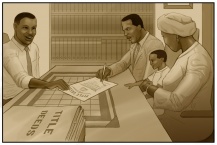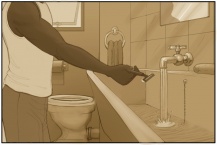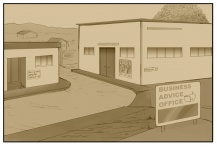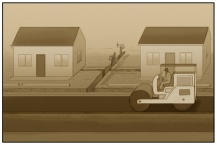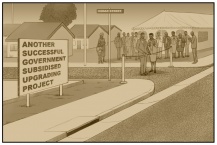Story 4: Upgrading

Pam and her neighbours have achieved a lot in the 7 to 8 years that they have been on the land in Bongweni without much government support. They have used what money and resources they could get to build themselves some very nice homes, even if these houses were not complete.
The housing process has been turned upside down from one where people used to wait for government subsidies to come first and then use their own money to add to what government provided; to one where they first used their own resources (with a little support where possible) to build and create houses and neighbourhoods they could afford and then used government money to add to what they had already started.
We now turn our attention to how government money and resources can be used to add to what people have started for themselves.
Contents |
Upgrade tenure
About 8 years after we moved onto the church land the municipality was ready to help us upgrade our settlement.
By this time the households that had moved onto the neighbouring municipal owned land that was also developed as a managed land settlement project, had also been living on their land for about 2 years.
When the municipality started to plan for the development of the neighbouring municipal owned land, using a similar managed land settlement approach, we (as residents associations on the church land) negotiated with the municipality that when they upgraded the tenure, services and houses of people living on the municipal land we would also form part of that upgrading process.
When the Municipality was ready to start the upgrading of the new settlement on their land they arranged a workshop with us (the blocks on the church land) and explained how the upgrading was going to happen.
Remember that before we settled on the church land, the church land had been sub-divided into about 5 blocks and the area zoned as a sub-divisional area. The sub-divisional area plan (or draft general plan) had been approved by the municipality but a general plan had not yet formally been submitted to the Surveyor General for approval. This meant that we had legal status and that the municipality could “see” us.
Now it was time to formally subdivide the land into individual plots for each household. We had to have our technical experts brought in to explain how our rights needed to be upgraded from the “basket” of rights we held in our sub-divisional areas to rights we would hold as individuals.
As residents associations or blocks in the Bongweni community, we agreed with the church that the municipality would be the best placed to take responsibility for managing the whole land transfer process. It was easier for the municipality to get funds to pay for the land surveying and conveyancing involved then for the church to do this (see financing upgrade section below for more on this). A development agreement was signed between the church, ourselves, represented by Twin Oaks Residents’ Committee (and other associations for the other blocks), and the municipality, where the church (as the land owner) and the resident associations agreed that the municipality would be responsible to manage the tenure upgrading process. This agreement gave the municipality power of attorney to act on behalf of the church when it came to land transfer. (A similar agreement was also signed for the municipality to take responsibility for upgrading the services – see the next section on services upgrading).
This land transfer process involved a number of steps.
- The land surveyors appointed by the municipality, as per the agreement with the church, came and used their special equipment to mark out the corners of the plots we had marked out by tape measure at the start of the development process. They called this a ‘tacky’ or tachometric survey.
- Town planners appointed by the municipality (as agreed with church) obtain formal sub division consent from the municipality. This activates the residential 1 zoning that was specified in the original sub divisional zoning motivation, made in the bulk land preparation phase, as the ultimate zoning of the property.
- The land surveyor then prepared a general plan based on this on-site tacky survey mapping. The general plan was based on the way we had settled already. The original draft general plan (or sub divisional area – or framework - plan) prepared during the bulk preparation stage had only marked out the outer boundaries of the blocks and had not been formally submitted to the surveyor general. The new general plan that was prepared at this upgrading phase showed each individual plot on the plan.
- The land surveyor then sent the general plan to the Surveyor General for approval and each plot was given an erf number.
- The conveyancer (also appointed by municipality as agreed with the church as land owner), took the approved general plan and opened a township register in the deeds office (with each erf belonging to the church).
- The conveyancer then had to arrange to legally transfer the land from the church to someone nominated by the household to take ownership of the plot. There were a lot of forms that had to be signed at this stage and at the end of all this, the households were given title deeds. This was quite a complicated process and for much of it we had to trust our advisors and the conveyancers involved. Each household was then given title deeds to their plot or erf and the roads and open space was then transferred to the municipality for those blocks that wanted this.
There was some complication when it came to how land transfer would happen for those households that did not qualify for a government housing subsidy, as they had to use their own money to pay the transfer/ conveyancing fees. The church had donated the land to us (and had not stipulated that only housing subsidy qualifying beneficiaries could be allocated), so there was no land price but there was a legal transfer cost.
Most of the blocks agreed that the municipality would take over ownership and responsibility for the roads and common space within the blocks, but our block and another block decided to keep group ownership of this space so we could control what happens on this space. We had to establish a home owners association, with its own constitution, to take ownership of this space. This was easy for us as we had already been operating like a home owners association with Twin Oaks Residents Association. The home owner association rules were based on the rules we were already using in the residents association. We also included some cooperative clauses like one member one vote in the home owners’ association constitution. The conveyancer then had to transfer the common space (internal roads, etc) from the church to the home owners association.
We were worried how we would be able to force households to pay the home owners association monthly levy, so we arranged with the municipality to reduce our refuse charges as we were going to continue to collect this refuse ourselves and place it in a central point. The remaining refuse funds that we would have paid to the municipality, had we paid the full refuse charge, would be paid to the home owners association. In effect households still paid the full amount for refuse, but the municipality then refunded the home owners association a small amount. As a home owners association we were able to decide how we wanted to use this money to maintain the common space.
We considered setting up a cooperative to own all the land collectively, including each of the plots, but in the end decided against this as we did not know enough about how this would work for each plot. Having a cooperative-like home owners association was good enough for us to keep our sense of belonging as a group.
Now that households had title deeds to their individual plots they could sell their plots like they would in the normal private sector property market. We were told that, with individual title, those households that could demonstrate that they had sufficient income could also use their property as collateral and get a bond. I only know of one person, who got promoted in his job, who has managed to get a bond in this way to be able to build a better house. For the rest of us the banks have not been to keen to give us mortgage loans. There are a few micro finance lenders who are able to give us loans but they do not use housing property as collateral. See section on aided local resource mobilisation in the aided self development phase for more on non mortgage forms of housing finance.
Being able to get loans, using property as security, has some advantages but it also opens up the possibility that households could lose their property to banks if they are unable to pay this loan/ bond back. When we had the right to occupy, banks would not give us loans and we had to rely on micro loans through our savings schemes that were not attached to our property. Households could not lose their home if they failed to pay back the micro loan, they just could not get more micro loans, and there was peer pressure from other members of the savings schemes to pay back.
Visit Tenure for more information and discussion on this topic.
Upgrade services
As blocks we also agreed that the municipality would act as the developer for upgrading the services. A three way agreement between the church, ourselves (as residents associations) and the municipality had to be signed for the municipality to act as the developer for the upgrading of the services.
The municipality had by this time finally upgraded the bulk water and sewerage system so they were able to upgrade to water per house and a waterborne sewerage system. Apparently they had installed some form of new biological waste water treatment system that would treat all the sewerage from the church and municipal owned land at a special treatment plant that used reeds and other biological methods to treat the sewerage.
Another workshop was arranged by the municipality to explain to us what options we had for upgrading services. At Twin Oaks we decided to upgrade to water per houses, but we decided not to upgrade to waterborne sanitation, as we had got used to the double pit urine diverting composting toilet. Not all households had built such a toilet on their own plots and were still using the communal toilets per every 4 houses, so the government money was used to provide everyone with this composting toilet.
We also used some of this money to improve some of the roads, pedestrian paths and storm water channels, including the construction of more storm water retention ponds (to hold storm water for a short period of time and let is slowly out) and detention ponds (to keep water permanently stored), that could be linked to some of our agricultural activities.
The Municipality put a clause into the engineering services tender documents for the builder of the services to use the labour teams that had been involved in upgrading some of the storm water systems and roads in the aided self development phase (that had been funded by the community works programme).
After about 4 years of us living on the land, the power utility company using government electricity grants, put in public and private electricity. Each household could buy a subsidised electrical pre-payment meter. The power company workshopped with the blocks where the best place would be for the public lighting. For example, lights were placed at intersections and in the common spaces.
visit Services and Facilities for more information and discussion on this topic.
Upgrade facilities
The upgrading committee that we had established during the aided development phase, that involved the church, government and representatives from the blocks, was quite active in the aided self development phase in trying to get all the government departments to provide and upgrade the facilities and services in the neighbourhood.
I was not involved in this committee so I am unable to explain exactly what happened. All I know is that the upgrading committee, working with the municipality, was able to negotiate, for example, for the Education Department to upgrade the primary school. The multipurpose space that was created during the aided self development phase was also upgraded by combining various departmental functions into a nice hall with offices. The Department of Health upgraded the clinic and expanded the household food security/ nutrition centre; the Department of Home Affairs upgraded the welfare pay point office; the police upgraded the satellite police station; and a new post office was built.
Also, the Departments of Economic Development (for a business support centre and advice office), Transport (for bus stops), and Science and Technology (for a pilot resource centre/ computer centre) helped upgrade the multipurpose economic development support centre that was built on the new municipal land near the new BRT (Buss Rapid Transit) stop.
Visit Services and Facilities for more information and discussion on this topic.
Upgrade access
The municipality had planned for a bus service but this was not started when we moved in. By the time the municipality had made some progress in planning for the managed land settlement project on its land, the new Bus Rapid Transit (BRT) system was being rolled out. We managed to convince the municipality and BRT agency to build the bus stop on the route past our piece of land before people started to move onto the municipal land (as it was on the route anyway and the neighbourhood was growing around it).
The municipality kept some of the properties around this BRT stop for its own use and sold the rest, so it was able to build the small business support centre and incubator next to this interchange which helped small businesses a lot as when the area grew these businesses had a good market.
The new BRT bus stop was a little further away on the municipal land so we had to walk about 10 minutes more to get there, but it was much cheaper than the taxi’s and with one ticket you could go through the central bus stop in town and catch another bus to other parts of the town.
The development of the new Special Development Zone nearby also helped improve access as now there were jobs and shops and other things closer to where we were living and those who had work there did not have to travel long distances to other parts of the town anymore for work.
Visit Access for more information and discussion on this topic.
Upgrade house
After years of hard work, and a long process we finally came to the issue that started the whole process; accessing government subsidised housing.
Strangely, this was now a bit of an anti climax as we had been living in houses we had arranged to build for ourselves for about 8 years by this stage.
One of the issues that we had to address was who could qualify for a housing subsidy. Out of the about 100 households on the church land there were about 20 households that did not qualify for a housing subsidy. About 8 of these 20 households had already owned property elsewhere, while the remaining 12 earned more than the minimum subsidy qualifying amount.
The 12 who earned more than the qualifying amount had to arrange for an individual subsidy that provided a subsidy amount for top structures proportional to their income. The 8 that had owned property elsewhere were not given any top structure funding and had to continue to rely on their own resources.
Another issue we had to address was what type of house would be built with the subsidy money and how would it be built.
It was agreed that the houses would be built following the Peoples’ Housing Process. All the blocks agreed to use the Development Support Organisation as our community resource organisation. The Development Support Organisation contracted an engineering firm and a social facilitation consultancy to actually do the project management.
Two workshops were held. At the first workshop we discussed how best to use the government subsidy to add to what we had already started. After the engineers had developed various options based on this discussion they reported back at the second workshop where it was agreed that households would be able to choose from the following list of options:
- Option 1: Full house: where the support organisation arranges for a builder to build a complete house. Very few people chose this option, but where they did it was usually in front of their temporary house.
- Option 2: Material and labour: Fees for labour (that were estimated as a percentage of the material used) and vouchers for material from approved material suppliers that only allow subsequent tranches to be made once a building inspector had checked that the housing element (e.g. foundations) was built using the previous tranche.
- Option 3: Material only: Only vouchers for material as described above; with households having to arrange their own labour.
Some people had collected their own material and wanted to add this to the government material, but in the end, to avoid any confusion, it was agreed that if people wanted to use their own material they could do this on other parts of the house and not on the part that was built with government subsidy money.
Each household had to develop a plan for what they wanted to do with the subsidy money. This was a quite a complicated arrangement for options 2 and 3, but given the experience households had in budgeting and building their own houses it was fairly easy for them to understand all that was involved.
Given that our family (and other families) had obtained building plan approval for elemental houses, we were able to use the subsidy to add to this house. For example, my house had approval for the elemental floor foundations and floor, with roof on poles and with wet core, so we were able to use the government subsidy money to build proper, well-insulated walls and ceilings, and add on more rooms to the side were we previously had temporary rooms.
The Municipality by this time had established an upgrading support office in the area serving the people living on the municipal land. This person (and her team) played an important role in helping to approve these building plan options and administer the process of approving construction completion stages and making payments.
A third issue we had to address was what to do with the temporary houses that people had built in previous stages. We have been unable to reach a clear solution on this and it’s still being discussed. There are not as many temporary structures anymore as people have either obtained building approval for self built houses and elemental houses, and/or they have built approved houses using the government housing subsidy.
It has also been difficult in many instances to differentiate between a temporary and a permanent houses, as some of the temporary structures have been built to very good quality. Most of these have been allowed to stay. The one thing that was agreed is that unsightly temporary structures had to be removed. The municipal building advisor and representatives for the various blocks would approach households who in their opinion had unsightly temporary houses and negotiate with these households for these structures to be removed or improved. Generally households understood this and complied, but there are still a few households where negotiations are continuing.
Visit Housing for more information and discussion on this topic.
Financing upgrade
The funding for the upgrading phase mainly comes from the Governments Upgrading of Informal Settlement subsidy. The services component of this subsidy has been used to upgrade the services for the whole settlement area. It does not matter if some of the households in the settlement do not qualify for a housing subsidy. These services funds were also used to survey all the plots.
The funding for improving each person’s house was from the top structure component of the upgrading of informal settlement funding. Only households who qualified for this subsidy were eligible to access these funds. Those that earned below R3 500 per household per month obtained the full subsidy and those that earned above this, but below the maxim qualifying band of about R7 000/ month, obtained progressively less as their household income increased. As explained in the up grading top structure section, those that had owned property before did not qualify for the top structure component.
Given that the area had been planned previously, this upgrading of services and house was much easier than if the area was upgraded from an informal settlement.
It was agreed that the municipality would upgrade the services on both the municipal and the church land as part of one upgrading process. This process was broken up into phases over a three year period, with our plots on the church land and some of the blocks on the municipal land being part of year one upgrading.
visit Financing for more information and discussion on this topic.
Comments
Join the MLS conversation: Comments page

